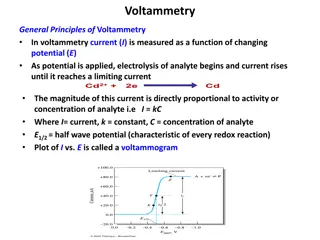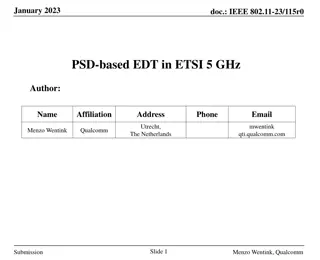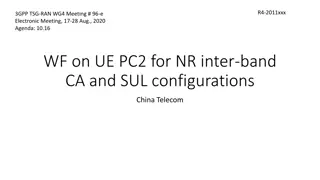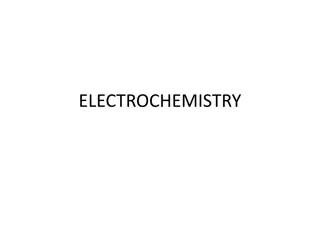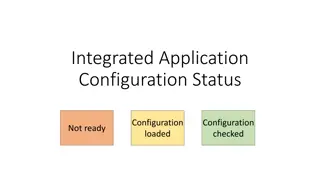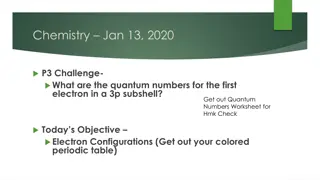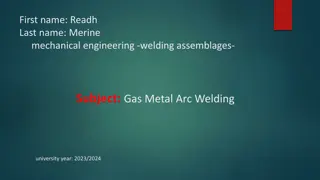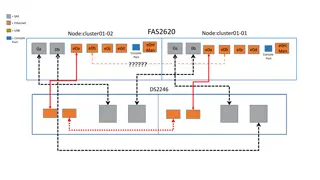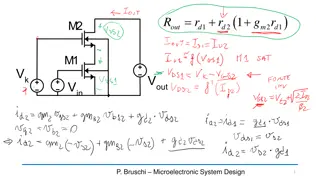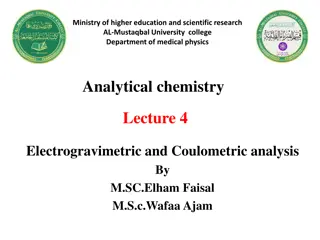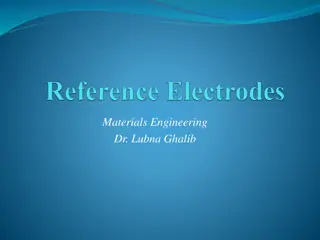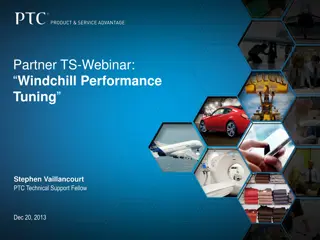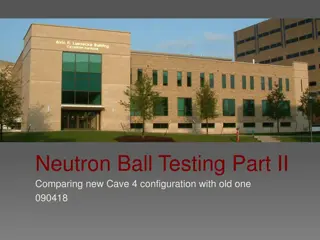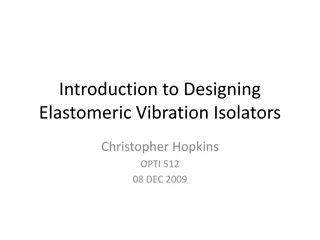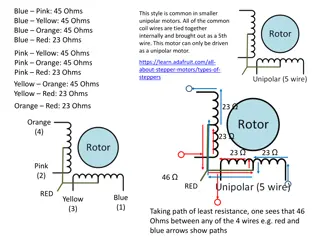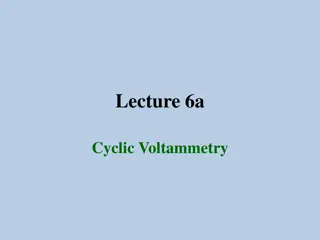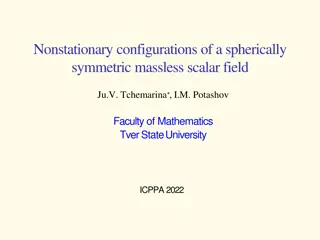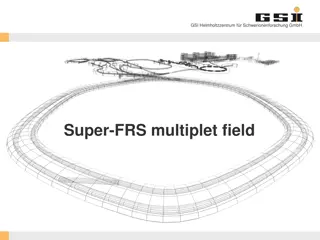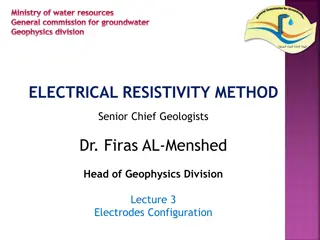Understanding Atomic Configurations and Term Symbols
The energy of atomic configurations is determined by electrostatic attraction between electrons and the nucleus, electron-electron repulsion, spin-orbit coupling, and spin-spin interactions. Term symbols in electronic spectroscopy specify atomic states using quantum numbers. Hund's rule and the Paul
8 views • 12 slides
Understanding Voltammetry: Principles and Applications
In voltammetry, current is measured as a function of changing potential. The magnitude of current is directly proportional to the activity or concentration of the analyte. A voltammogram is plotted between current and potential, showing the characteristic half-wave potential. The process involves a
6 views • 76 slides
Understanding Chemical Bonds and Ionic Compounds
Ionic bonds are formed when atoms transfer electrons to achieve stable electron configurations, resulting in the creation of ions with positive or negative charges. Metals are good conductors due to their ability to easily lose electrons. The charges of ions depend on the number of valence electrons
0 views • 49 slides
Understanding Ionic and Metallic Bonding in Chemistry
Explore the concepts of ions, electron dot structures, the octet rule, cations, and anions in Chapter 7. Learn how elements achieve stability through electron configurations, and practice writing electron dot structures and naming ions. Understand the differences between cations and anions and how t
1 views • 52 slides
Understanding Bridge Loading and Rating
Bridges are subjected to various types of loads such as dead load, live load, and other loads like wind and temperature effects. Dead load consists of the bridge's self-weight, while live load includes temporary moving loads. Bridges are rated to determine their load carrying capacity, especially in
0 views • 21 slides
Understanding the Electrical Activities of the Heart - An Overview
The electrocardiogram (ECG) is a result of intricate physiological and technological processes involving transmembrane ionic currents, cardiac activation sequences, and electrode connections. The cardiac conduction system consists of various components like the sinoatrial node, atrioventricular node
0 views • 39 slides
PSD-based Energy Detect Threshold (EDT) in ETSI 5 GHz Standard
ETSI BRAN adopted a PSD-based EDT into the 5 GHz standard, specifying thresholds for energy detection levels. The new definition replaces the previous -72 dBm/20 MHz EDT, offering a compromise between power limits and channel configurations. Detailed examples and operational guidelines are provided
0 views • 6 slides
Understanding Bipolar Transistor Configurations for Electronic Circuits
Explore the three common configurations - Common Base, Common Emitter, and Common Collector - for Bipolar Transistors in electronic circuits. Each configuration offers unique characteristics such as voltage gain, current gain, and impedance levels, impacting the signal processing and amplification c
0 views • 27 slides
Discussion on Multi-PUSCH Configuration for UTO-UCI Content Moderator at Ericsson
This discussion encompasses the configuration and implications of the Multi-PUSCH setup based on agreed parameters within the UTO-UCI content moderation context at Ericsson. It delves into varying configurations, potential impacts, and considerations for effective utilization. The slides provide ins
0 views • 17 slides
Understanding Feedback Amplifiers in Electronic Circuits
Feedback amplifiers play a crucial role in electronic circuits by providing mechanisms for controlling gain, stability, and overall performance. There are two basic types of feedback - positive and negative, each offering distinct advantages. The four ways of connecting feedback signals involve volt
1 views • 18 slides
Understanding Resistivity Measurements in Geology
Explore the concept of resistivity measurements in geology, focusing on electrode configurations such as Wenner and Schlumberger arrays. Learn about the potential differences in electrode setups and how to calculate apparent resistivity through geometrical factors. Various electrode arrangements and
0 views • 22 slides
Electronic Meeting Agenda: UE PC2 for NR Inter-Band CA and SUL Configurations
The document relates to the upcoming electronic meeting of 3GPP TSG-RAN WG4, focusing on UE power class 2 for NR inter-band Carrier Aggregation and supplemental uplink configurations. It includes background contributions, identified issues, and options for SAR schemes addressing duty cycle based sol
5 views • 5 slides
Understanding Electrode Reactions in Electrochemistry
Exploring electrode reactions in electrochemistry involves delving into Faraday's law, coulometry, and the importance of sustainable electrode reactions. These concepts help us understand how the quantity of charge passed affects the production or consumption of substances in electrode reactions. As
4 views • 27 slides
Understanding Electrochemistry: Principles and Applications
Electrochemistry is a branch of chemistry focusing on electricity generation from spontaneous chemical reactions and utilizing electrical energy for non-spontaneous transformations. It encompasses important concepts like electrolytes, electrode potential, electrochemical cells, salt bridges, and the
0 views • 20 slides
Understanding Assignment Rosters in IROC Training
Explore the process of managing assignment rosters in IROC training, which involves creating rosters specific to requests, filling requests with configurations, and generating assignment rosters. Learn about the lifecycle of assignment rosters, filling options, and using single resources or master r
0 views • 24 slides
Configurations and Tests Overview in Integrated Applications
This content provides an overview of various configurations and tests in integrated applications, covering aspects such as status, loaded configurations, readiness checks, server tests for HV and LV systems, as well as client-server interactions. It details the different components involved and thei
0 views • 5 slides
Welding Current Selection and Electrode Factors in Shielded Metal Arc Welding
When selecting the welding current for Shielded Metal Arc Welding (SMAW), considerations such as plate thickness, cable length, arc initiation ease, arc blow, and welding position play crucial roles. Direct Current (DC) is preferred for thin sheets and odd position welding, while Alternating Current
0 views • 10 slides
Advancements in Neurosurgical Instrumentation and Techniques
Thermal energy for hemostasis has a rich history dating back to ancient Egypt, evolving through fire drills, Bovie and Cushing's methods, and the introduction of lasers. Various electrical waveforms are used in neurosurgery, each with specific heating effects. Electrical energy ranging from 250,000
0 views • 55 slides
Understanding Quantum Numbers and Electron Configurations in Chemistry
Explore the quantum numbers for electrons in subshells, learn about electron configurations and filling rules, and grasp the concepts of orbital energy levels in chemistry. Discover the Aufbau Principle, Pauli Exclusion Principle, and Hund's Rule through engaging activities and worksheets.
1 views • 18 slides
Gas Metal Arc Welding (GMAW) Equipment and Functionality Overview
Gas Metal Arc Welding (GMAW) is a versatile welding process that utilizes a consumable electrode wire, electric arc, and shielding gas to join metallic materials efficiently. This method requires essential equipment like power source, consumable electrode wire, wire feeder, welding gun, shielding ga
0 views • 10 slides
Networking Setup Overview for FAS2620 and FAS2240 Systems
This content provides detailed information about the networking setup for FAS2620 and FAS2240 systems, including connections, ports, and cabling configurations. It includes images and descriptions of the setup for cluster configurations, disk shelves, and switch connections.
0 views • 5 slides
Understanding Static Routing in Network Infrastructure Workshops
Explore the concepts of static routing in networking workshops, covering Unix and Cisco network interface configurations, static routes, default routes, and advantages and disadvantages of static routing. Learn about IP routing configuration, assignment of IPv4 addresses, and FreeBSD network interfa
5 views • 37 slides
Understanding Horizontal and Backbone Cabling in Network Architecture
Explore the fundamentals of horizontal and backbone cabling in network architecture. Learn about their segments, configurations, and types. Discover how horizontal cabling connects devices to outlets and back to the telecommunications room, while backbone cabling links multiple buildings or sections
2 views • 18 slides
PDSCH Demodulation Parameters & Requirements Discussion
This document covers the discussion on PDSCH demodulation parameters and requirements for UE demodulation and CSI reporting in FR2 DL 256QAM, specifically focusing on static channel mode, TDL-D channel mode, and TDL-A channel mode. The document also explores rank options, channel bandwidth, PRB allo
0 views • 9 slides
Microelectronic System Design by P. Bruschi - Overview of Cascode Current Mirrors and Wide Swing Configurations
Explore the detailed design of microelectronic systems by P. Bruschi, focusing on cascode current mirrors and wide swing configurations. The content includes various images illustrating classic and non-optimal topologies, parameters, and voltage shifters for MOSFET mirrors. Learn about high precisio
0 views • 14 slides
IEEE 802.11-24/0858r0: Key Concepts on NPCA and Virtual APs
This document discusses key concepts related to NPCA (Neighbor-Primary Channel Announcement) and Virtual Access Points (APs) in the context of IEEE 802.11 standards. It covers topics such as multiple BSSID sets, co-hosted APs, NPCA primary channel configurations, and criteria for channel switching.
0 views • 9 slides
Understanding Electrogravimetry for Analytical Chemistry Applications
Electrogravimetry is a technique utilized for the precise separation and quantification of metal ions in a substance. By depositing analytes on electrodes through electrochemical reduction, this method enables accurate determination of metal concentrations in solutions. It finds applications in quan
0 views • 21 slides
Hardware Configurations for Project Cysera by Zoebir Bong
This document outlines proposed hardware configurations for Project Cysera drafted by Zoebir Bong. It includes options from Dell and Lenovo servers with both remote and local data storage solutions. Each configuration specifies server models, network switches, processors, memory, storage drives, net
0 views • 8 slides
Understanding Electrode Potential in Materials Engineering
In materials engineering, understanding electrode potential is crucial. The hydrogen electrode serves as a reference for potential measurements in aqueous solutions, but has limitations in oxidizing media. On the other hand, the silver-silver chloride electrode provides a dynamic equilibrium between
0 views • 15 slides
Windchill Performance Tuning Webinar Insights
Explore common themes of Windchill performance issues and learn preventive measures to enhance system stability and user experience. Delve into database-related causes, system misconfigurations, and client-side configurations. Discover essential tips for optimizing database performance and server/cl
0 views • 12 slides
Comparison of New and Old Cave Configurations in Neutron Ball Testing
This content discusses the comparison between the new and old cave configurations in the Neutron Ball testing part II. It showcases images and descriptions of the different cave configurations, highlighting the progress in research at the Cyclotron Institute. The Neutron Ball's functionality and tes
0 views • 14 slides
Designing Elastomeric Vibration Isolators: Key Parameters and Configurations
Exploring the design aspects of elastomeric vibration isolators, including material selection, key design parameters, simple isolator configurations, spring rates, transmissibility, and shape factor calculations. Learn how engineered properties of elastomers can meet specific application requirement
0 views • 26 slides
Understanding Unipolar Stepper Motors and Motor Control
Unipolar stepper motors are commonly used in smaller applications, with specific coil wire configurations that allow them to be driven only as unipolar motors. This guide outlines the wiring configurations, coil phases, and motor control steps for efficient operation of these motors.
0 views • 9 slides
Understanding Electron Configurations and the Periodic Table in Chemistry
Explore the world of electron configurations in atoms, subshells, and electron arrangement using the periodic table. Learn about the organization of electrons in subshells, different ways to represent electron arrangements, and how to determine electron configurations based on the periodic table. Di
0 views • 12 slides
Understanding Cyclic Voltammetry in Electrochemical Methods
Electrochemical methods, such as cyclic voltammetry, are crucial for studying electron transfer processes, redox reactions, and adsorption on surfaces. Cyclic voltammetry involves varying the applied potential at a working electrode to monitor electron flow and chemical reactions. Peaks in the curre
0 views • 11 slides
Nonstationary Configurations of a Spherically Symmetric Scalar Field
Action and stress-energy tensor, Einstein-Klein-Gordon equations, and method for constructing nonstationary configurations of a spherically symmetric scalar field are discussed in this study. The behavior of the characteristic function allows interpretations such as black holes, wormholes, or naked
0 views • 14 slides
Overview of Magnet Configurations at GSI Helmholtzzentrum GmbH
This document provides detailed information on the magnet configurations at GSI Helmholtzzentrum GmbH, focusing on multiplet designs, magnetic field simulations, quadrupoles, sextupoles, and steering dipoles. It covers the general design of SC multiplets, requirements on axis and angles, and specifi
2 views • 17 slides
Understanding Electronic Configurations Through Simplified Assignments
Exploring electron configurations and orbital regions using simplified notations colored in on Periodic Charts. Descriptions and visual aids for Carbon, Fluorine, and excited state of Fluorine. Learn to assign s, p, d, and f electron neighborhoods without memorization through a fun song. Includes te
0 views • 14 slides
Geophysical Methods for Groundwater Exploration: Electrodes Configuration and Array Types
The lecture discusses the utilization of electrical resistivity methods in geologic investigations, focusing on electrode configurations such as symmetrical linear and non-linear arrays. Detailed insights are provided on the Wenner and Schlumberger arrays, including their properties and depth of inv
0 views • 12 slides
DC Motor Control Techniques and Configurations
This chapter delves into various aspects of PWM and DC motor control, exploring characteristics of selected DC motors, rotation mechanisms, H-bridge configurations for motor direction control, logic configurations for motor operation, bidirectional motor control using an L298 chip, pulse width modul
0 views • 27 slides

